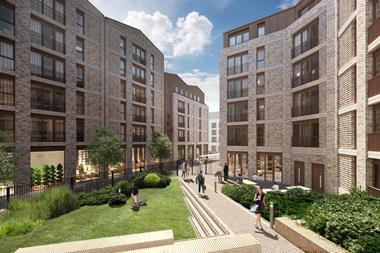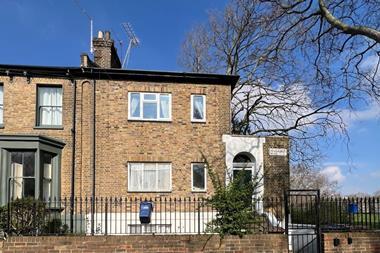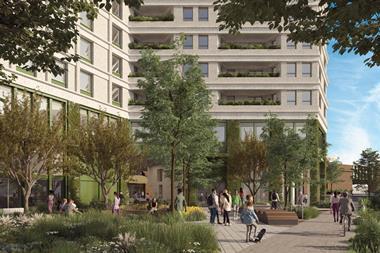Grosvenor Property UK’s chief executive James Raynor is in the interview seat on BossCast this week, discussing how the historic estate balances innovation and stewardship, the importance of diversity in creating strong teams, and its role in fostering economic growth – not just in London’s West End, but across the UK and indeed the globe.
LISTEN to this podcast via Apple, Amazon, Spotify or SoundCloud (and many other platforms) or just use the player below:
Despite Grosvenor’s foundational role in making London’s built environment what it is today, its boss James Raynor spent the formative years of career in another great European capital – Paris.
Starting out as a graduate at the Royal Bank of Scotland, after writing a report on investment opportunities in the European market, James was singled out as one of the few people on the team who spoke any French, ultimately ending up with him leading the bank’s activity in Paris.
His experience in structured financing for French real estate then led him to Grosvenor’s office in the French capital.
It’s certainly made an impact on his professional outlook. “It’s good to go somewhere where you are a fish out of water and you’ve got to find your own way, create your own network, learn from a very low knowledge base and work hard,” he explains.
When Raynor was eventually recalled back to Grosvenor’s London office in 2012, he brought a fresh approach to the 350-year-old company – whose British and Irish operation he would lead from 2020.
“I do not identify with the idea that I’m here to preserve,” he says. “I’m incredibly conscious of the heritage, the standards, the qualities and the values of the business, but the world is constantly moving forward – and in much shorter cycles than before.”
The openness to a variety of experiences is evident in Grosvenor’s approach to its employees and culture.
“There are two aspects to a real estate business,” he remarks. “The buildings, and the people. And our people want an environment that is supportive. That’s core to our DNA.”
Part of that strategy, Raynor explains, is enabling people to make mistakes, rather than “mitigating every single possible thing that could happen and therefore not doing anything.”
The breadth of talent at Grosvenor has allowed the company to undertake some truly ambitious projects, such as the regeneration of the eponymous Grosvenor Square – the second largest in London, at 2.5 hectares.
“Its main purpose at the moment is to find a way to walk across it quite quickly,” Raynor jokes.
“Now we’re creating a cultural and leisure destination where people would want to go there not to walk through it, but stay there, enjoy it, and perhaps learn about biodiversity in the educational centre.”
Indeed, biodiversity sits at the heart of the strategy, which will see the square not just have a series of plain trees, but a range of greenery that will provide light, shade, and ultimately a far more interesting landscape.
The project was recently hailed by Westminster Council as an “exemplary form of stakeholder management”, in which Grosvenor consulted a wide range of groups, including the Mayfair Youth Forum, local councillors, local residents, and people who worked in the area.
“Bringing them on the journey with us was important to its success,” Raynor adds.
LISTEN to this podcast via Apple, Amazon, Spotify or SoundCloud (and many other platforms) or just use the player above.
The Grosvenor Square project is a powerful example of what Raynor calls “environmental leadership in the built environment”.
As such, Grosvenor has signed up to the Science Based Targets Initiative, a particularly ambitious carbon reduction programme, and was one of the first companies to set out a 2030 net zero pathway.
“If we can lead the way, demonstrate that it’s possible, and show real leadership around the issues, then we will create momentum,” he explains.
Its £90 million estate refurbishment plan is a keystone in this strategy – but Raynor refuses to simply see this sort of green-led retrofitting initiative as a cost to the business.
“I view it as a value driver,” he notes. “The industry thinks of it as a cost, but it’s only a cost in the sense that it hasn’t been properly reflected in valuations yet.”
However, the government could certainly be offering carrots as well as sticks in order to green the built environment, Raynor thinks.
“The government could green a swathe of the economy if it provided more incentives,” he says, “even tax incentives would come back, because they are going toward hiring people, paying wages, and other things that are very positive for the country.”
Yet the planning system continues to prove a sticky obstacle. “How do you fast track planning applications where one of the core purposes is to improve the environmental performance of a building?” he asks openly. “We have a finite time to make changes. You don’t want to waste 18 months passing papers between a variety of agencies.”
For Raynor, sustainability is bound up with a tech-driven approach – which is reflected even in the names of Grosvenor’s departments.
“It’s called the Sustainability and Innovation Team because we felt that the move towards sustainability was also about us embracing innovation,” he says. “We were never going to be able to solve all of the issues with the tools that we currently had.”
This has led Grosvenor to setting up an Alternative Investment business backed by £65 million of capital, which is essentially a VC fund to support its UK sustainability ambitions. Demand Logic, a building management system, and Stack, a digital footprint measurement tool, are numbered among its forward-thinking investments.
LISTEN to this podcast via Apple, Amazon, Spotify or SoundCloud (and many other platforms) or just use the player above.
Still, Grosvenor is perhaps best known for its imprint on London’s West End, where most of its properties were historically located.
Raynor thinks that the area has been so successful – he notes it’s likely responsible for some 10 percent of the UK’s GDP – because it has “responsible property owners who think for the longer term, and think about the curation of place.”
Nevertheless, “we don’t want it to be a museum,” he adds. “We want it to evolve for several generations to come. That thoughtful evolution of place is ingrained in us, and in many others as well.”
Visitors to London’s West End will however have noticed the sorry state of Oxford Street in recent years, a sticking point Raynor is well aware of.
It’s what happens when “there isn’t a lot of contiguous ownership”, he argues.
Still, there are reasons for optimism, with the Elizabeth Line providing a huge draw for the area, and indeed Business Improvement Districts (BIDs) making a concerted effort to improve the public realm.
Nevertheless, Raynor thinks there was a missed opportunity. “I would have preferred it to be more radical,” he remarks. “I love the thought of wholly pedestrianised Oxford Street: a great green street in the middle of a global green city.”
While Grosvenor’s historic focus may have been the nation’s capital, its investments now span 47 cities worldwide. In the UK, it has seen particular value in regional urban centres, such as Manchester, Bristol, Birmingham and Leeds, where the estate now spans 500,000 sq ft of offices.
Explaining the importance of these cities, he says: “I’m a very big believer in what is the power of education within a city, particularly higher education.”
It certainly helps that a range of dynamic industries have spurred growth there in recent years. “There’s been more job creation in those cities than in London on a percentage basis over the last ten years,” he says.
Still, as the “only truly global city in Europe”, London remains of key importance – and levelling up the regions isn’t a zero-sum game to be balanced with the capital.
“London isn’t competing with Birmingham, Manchester or Bristol,” Raynor observes. “It’s competing for global international capital versus New York, Tokyo, Los Angeles or Paris.”





























No comments yet